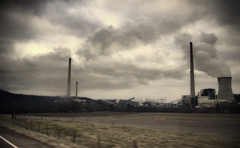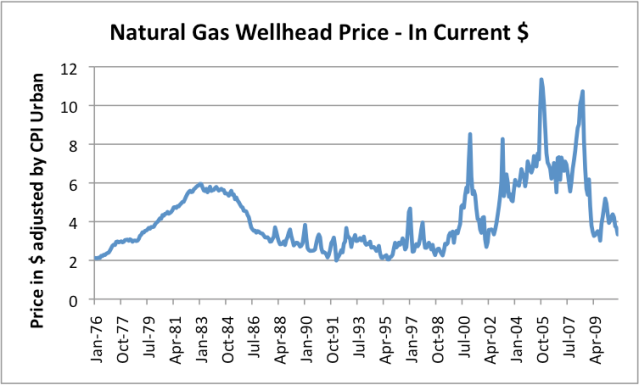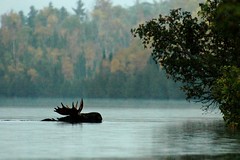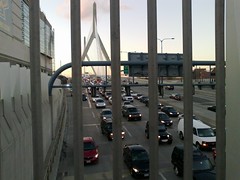I'm a firm believer that we could cut the numbers of public streets available to traveling cars in half (or at least cut the width of most streets in half) and we'd all be happier with the added space for gardens, shade trees, dinners outdoors and playing.
Here in the U.S., Park(ing) Day is a step in the right direction. But what if we went a step further?
In the U.K., a group called Playing Out encourages neighborhoods to organize limited after-school closings of neighborhood streets to allow children to play. New York City has a similar program called Play Streets.
Could a program like this work in your community?
Playing Out from Playing Out on Vimeo.
Via The Atlantic Cities
Thursday, February 28, 2013
Wednesday, February 27, 2013
It's Like Wind Turbine Syndrome With the Crazy Turned to 11
 Here in the U.S., media coverage with a tone of "scientists say this, people who sit around all day worrying what innocuous thing might kill them say that" media coverage perpetuates a false belief in the myth of "wind turbine syndrome."
Here in the U.S., media coverage with a tone of "scientists say this, people who sit around all day worrying what innocuous thing might kill them say that" media coverage perpetuates a false belief in the myth of "wind turbine syndrome."In South Korea, media coverage with a tone of "scientists say this, people who sit around all day worrying what innocuous thing might kill them say that" perpetuates false belief that a desk fan left on overnight can kill you.
I'm not saying the fear isn't real, or that people can't work themselves up to the point that they're feeling real symptoms. But they're both urban legends.
Monday, February 25, 2013
More Coal Closures in Midwest - When Will MA Go Coal-Free?
 The Sierra Club is announcing a big victory for clean air and climate action in the Midwest today:
The Sierra Club is announcing a big victory for clean air and climate action in the Midwest today:Today a coalition of citizen groups, states and U.S. EPA announced a landmark settlement agreement with American Electric Power (AEP) requiring AEP to stop burning coal by 2015 at three power plants in Indiana, Ohio and Kentucky. AEP also agreed to replace a portion of these coal plants with new wind and solar investments in Indiana and Michigan, bringing more clean energy on line to meet the region’s electricity needs. [...]Aside from the obvious climate and public health benefits, ratepayers in Ohio should be cheering this long-overdue move to get Ohio off its addiction to one source of energy. In 2009, Ohio was getting a ridiculous 84 percent of its energy from coal. That dropped to 78 percent by 2011, but with coal prices rising, natural gas prices plummeting and the cost of wind and solar dropping by the day, diversifying Ohio's electric portfolio is just good business.
Coal-fired power plants are the nation’s largest source of mercury, sulfur dioxide (SO2) pollution, carbon pollution and many other deadly pollutants that can trigger heart attacks and contribute to respiratory problems. According to estimates from the Clean Air Task Force, 203 deaths, 310 heart attacks, 3,160 asthma attacks, and 188 emergency room visits per year will be averted once the Muskingum River, Tanners Creek and Big Sandy power plants stop burning coal.
We've nearly weaned ourselves off of coal here in Massachusetts, but the Mt. Tom plant in Holyoke and the Brayton Point station near Fall River remain. (I'm sure it's just a coincidence that the only coal plants left are near poor urban areas.)
Tell Gov. Deval Patrick you want Massachusetts to go coal-free - and while you're at it, show your support for building Cape Wind now.
Even After the Climate Canary Has Died, Will We Keep Digging the Coal Mine Deeper?
From Washington Post political cartoonist Tom Toles:
Even as America weans itself off of coal-fired electrical power, coal corporations want to keep mining and export America's to developing countries. That way Americans don't get any of the electricity, but our natural resources are still plundered, our climate is still polluted, taxpayers are still on the hook, and big coal corporations still get to reap all the profit. What's not to like?
Even as America weans itself off of coal-fired electrical power, coal corporations want to keep mining and export America's to developing countries. That way Americans don't get any of the electricity, but our natural resources are still plundered, our climate is still polluted, taxpayers are still on the hook, and big coal corporations still get to reap all the profit. What's not to like?
Sunday, February 24, 2013
THIS is Cheap Heat?
I recently moved from an apartment building (well insulated with a lot of free heat from my neighbors) to an old house (poorly insulated, stand-alone). Even keeping our thermostat as low as we can and doing some weatherization work, our natural gas heating bill last month was $147.
I thought that was a lot, but then my aunt told me her bill for oil heating was $600 last month alone. Big New England electricity customers are also feeling the burn of high natural gas prices.
When people say "but clean energy might cost more" I reply "like our current system is so affordable?" There may be some bumps along the way, but isn't it worth at least trying a different path?
I thought that was a lot, but then my aunt told me her bill for oil heating was $600 last month alone. Big New England electricity customers are also feeling the burn of high natural gas prices.
When people say "but clean energy might cost more" I reply "like our current system is so affordable?" There may be some bumps along the way, but isn't it worth at least trying a different path?
Friday, February 22, 2013
Monday, February 18, 2013
"This River Healed Me"
A new documentary, Not Yet Begun to Fight, details a program to give wounded veterans a chance to find peace on a secluded river. It's a reminder that when we talk about the value of America's natural resources, it goes far beyond jobs & GDP.
Sunday, February 17, 2013
Overreliance on Gas, Offshore Wind Delay Burning New England
 Natural gas has been pitched as a "bridge fuel" by those who don't want to transition New England's electricity supply from dirty fossil fuels like coal and oil to clean energy sources like solar and wind right away.
Natural gas has been pitched as a "bridge fuel" by those who don't want to transition New England's electricity supply from dirty fossil fuels like coal and oil to clean energy sources like solar and wind right away.But the toll on the natural gas "bridge" has suddenly gone way up. That's not surprising since, as the chart shows, natural gas has always been subject to wild price swings. With New England now more dependent on natural gas than ever, supply has struggled to keep up with demand. As the New York Times' Matthew Wald reports, that's sent New England electricity prices spiking sharply this winter:
The six-state New England region and parts of Long Island are the most vulnerable now to overreliance on gas, a vulnerability heightened by a shortage of natural gas pipeline capacity, but officials worry that similar problems could spread to the Midwest.But natural gas companies aren't interested in selling it to New England at a discount. They want to export it to get top dollar on the international market:
“We are sticking a lot of straws into this soft drink,” said William P. Short III, an energy consultant whose clients include companies that move and burn gas. “This is a harbinger of things to come in New England, as well as New York.”
Several companies want to liquefy and export gas from the continental United States because of the shale gas glut, and the events in New England could affect that debate. Opposition has come mostly from domestic industries that use the gas. A spokesman for Senator Ron Wyden, Democrat of Oregon and chairman of the Senate Committee on Energy and Natural Resources, said Mr. Wyden saw the price gyrations in New England as a reason to “look before we leap ahead with unfettered exports of gas.”The natural gas price spike shows that while natural gas may be cleaner burning and at times cheaper than coal, it's still a bad idea to put all our eggs in one fossil fuel basket. The more we can diversify our energy sources with modern, clean energy sources, the more insulated we'll be from price spikes. (Plus there are plenty of questions about the health and water impacts of natural gas fracking.)
Today, there's not one offshore wind turbine harvesting wind energy off the Atlantic Coast. Not one! Wind may cost a little more to build up front, but Mother Nature isn't going to threaten to export our breezes to Europe unless we pay exorbitant prices.
It's been 12 years since Cape Wind was first proposed and our regulators have let big mansion money on the Cape tie it up in regulatory knots. Let's build Cape Wind now - and a lot more offshore wind to follow.
Chart via Our Finite World
Thursday, February 14, 2013
Happy Valentine's Day, Big Oil
Apparently penguins sound like Woody Allen and polar bears sound like union guys. Who knew?
Wednesday, February 13, 2013
Matt Damon Goes on Strike: No to Toilets, Yes to Clean Water
Matt Damon isn't a boutique activist trying to shed light on some obscure issue no one knows about. No, he's tackling the unsexy, big, lethal problem that's right in everyone's face: Lack of clean water spreading disease, particularly in Africa, South Asia and Central America.
You'd think someone who's dead serious about saving millions of lives would be tackling the issue with grim stoicism. Instead, Matt Damon has produced the funniest video about clean water I've ever seen to promote StrikeWithMe.org:
You'd think someone who's dead serious about saving millions of lives would be tackling the issue with grim stoicism. Instead, Matt Damon has produced the funniest video about clean water I've ever seen to promote StrikeWithMe.org:
Tuesday, February 12, 2013
Tonight's State of the Union: No More Yes Man?
President Obama's first four years saw him attempt to say yes to everything on climate and energy - yes to both the right policy choice AND the political pander. Tougher fuel efficiency standards and new air pollution limits? Yes! The fastest expansion of oil drilling in U.S. history? Yes!
This all-of-the-above strategy has been a failure - instead, we've gotten the worst of all worlds. More risky drilling than ever? Gas prices near record highs? Price tag for climate-fueled weather disasters hitting $188 billion? Yes, yes and yes!
Tonight, I hope President Obama continues his inaugural theme of making good choices and smart investments. He needs to keep saying yes to clean energy investment and yes to carbon emissions continuing to go down while economic recovery continues its upward track.
But he also needs to start saying no - no to America serving as the middleman for dirty, expensive Canadian tar sands. No to unlimited, untracked methane emissions from gas fracking. No to unlimited carbon pollution from existing coal-fired power plants.
The good news for President Obama is that making those hard choices is politically popular. Today's Washington Post poll finds more than half of voters support action on climate change, with just a third of voters in opposition. Climate-fueled extreme weather events like superstorm Sandy have shifted the center - climate action is now a clear political winner.
Now that's worth saying yes to.
This all-of-the-above strategy has been a failure - instead, we've gotten the worst of all worlds. More risky drilling than ever? Gas prices near record highs? Price tag for climate-fueled weather disasters hitting $188 billion? Yes, yes and yes!
Tonight, I hope President Obama continues his inaugural theme of making good choices and smart investments. He needs to keep saying yes to clean energy investment and yes to carbon emissions continuing to go down while economic recovery continues its upward track.
But he also needs to start saying no - no to America serving as the middleman for dirty, expensive Canadian tar sands. No to unlimited, untracked methane emissions from gas fracking. No to unlimited carbon pollution from existing coal-fired power plants.
The good news for President Obama is that making those hard choices is politically popular. Today's Washington Post poll finds more than half of voters support action on climate change, with just a third of voters in opposition. Climate-fueled extreme weather events like superstorm Sandy have shifted the center - climate action is now a clear political winner.
Now that's worth saying yes to.
Monday, February 11, 2013
Larry Summers' "Energy Transformation" is a Policy About Nothing
In today's Washington Post, Larry Summers has an op-ed saying we should rely more on dirty energy - but dirty NORTH AMERICAN energy!
Fourth, the transformation of the North American energy sector needs to be accelerated. This will have economic and environmental benefits. Those who will decide whether to approve the Keystone XL pipeline, which would run between the tar sands of western Canada and Nebraska, need to recognize that Canadian oil not flowing to the United States will probably flow to Asia, where it will be burned with fewer environmental protections.
Natural gas exploitation, too, could bring huge environmental benefits. Replacing coal with natural gas has much more scope to reduce greenhouse gas emissions than more fashionable efforts to promote renewables. A period of record-low capital costs and high unemployment is the best possible time to accelerate the replacement cycle for environmentally untenable coal-fired power plants. More generally, the production of natural gas and its use in industry should be a substantial job creator for years to come.
This is Summers' entire section on energy. I didn't lift his section on dirty energy out of a broader piece on clean energy or even a make-no-choices all-of-the-above piece. Summers thinks the entire key to our energy "transformation" is what we're already doing - more dependence on high-priced dirty oil, more privatizing our public lands and waters to Big Oil while socializing the risk of oil spills, more putting our water supplies at risk with gas fracking, no mention of climate change.
This is what passes for transformational thinking with the Very Serious People in Washington.
This is what passes for transformational thinking with the Very Serious People in Washington.
How Did Wind Turbines Do During the Blizzard?
 Many of the wind turbines in Massachusetts automatically shut down over the weekend due to the blizzard, annoying but necessary considering ice buildup can hurt a turbine's performance just as much as it would an airplane's. (Notable exception: Ipswich Wind, which had its best two-day stretch of catching clean energy in at least a month.)
Many of the wind turbines in Massachusetts automatically shut down over the weekend due to the blizzard, annoying but necessary considering ice buildup can hurt a turbine's performance just as much as it would an airplane's. (Notable exception: Ipswich Wind, which had its best two-day stretch of catching clean energy in at least a month.)One of the more entertaining myths pushed by anti-wind activists is that after an ice storm wind turbines will start aiming chunks of ice at distant homes like a carbon-fiber eye of Sauron. Studies have shown that if a turbine continues to operate even during an ice storm, ice may fall up to 90 meters away. But that's about 4 times closer than any home should be from a wind turbine, so consider yourself safe. Just to be sure, take this advice from The Green Miles: Do not hang out directly under a 130-meter wind turbine during an ice storm.
As is often the case with wind turbines, people worry more about the new weird-looking thing than they do about the existing and actually dangerous thing. Just as people worry about made-up health impacts of wind power while overlooking the very real and very deadly impacts of our dependence on coal-fired power, they worry more about ice chunks from wind turbines that I can't find any evidence have ever hurt anyone when ice chunks from ordinary buildings will murder you dead.
Friday, February 8, 2013
White Out: Will Climate Science Denying TV Weathermen Forecast Less Snow During Blizzard?
Today's massive Northeast blizzard must put climate science-denying TV weathermen in a tough spot. Do you stick to your political guns and forecast based on a world with no temperature increase - pretend there's less energy in the atmosphere for the storm to draw on, pretend the ocean isn't much warmer than usual to add moisture to it - and risk underestimating its strength?
Or do you forecast with the baseline of a warming world fueling extreme weather and acknowledge climate disruption is helping make "Nemo" into a monster?
My guess: All TV meteorologists incorporate climate impacts into their forecasts, but few (if any) talk about the influence of climate change in their on-air forecasting discussion.
Or do you forecast with the baseline of a warming world fueling extreme weather and acknowledge climate disruption is helping make "Nemo" into a monster?
My guess: All TV meteorologists incorporate climate impacts into their forecasts, but few (if any) talk about the influence of climate change in their on-air forecasting discussion.
Thursday, February 7, 2013
What If the Carbon Pollution That's Killing Moose Wasn't Invisible?
 Minnesota's moose are dying in jaw-dropping numbers. If they were dying in an oil spill, it'd be the lead story on the national nightly newscasts. But they're being killed by carbon pollution, which is invisible and hence in dispute! So we let the politics of carbon pollution take command and prevent us from confronting this like it what it is - a full-blown climate crisis for both wildlife and people.
Minnesota's moose are dying in jaw-dropping numbers. If they were dying in an oil spill, it'd be the lead story on the national nightly newscasts. But they're being killed by carbon pollution, which is invisible and hence in dispute! So we let the politics of carbon pollution take command and prevent us from confronting this like it what it is - a full-blown climate crisis for both wildlife and people.
Tuesday, February 5, 2013
On America's Congested Highways, Every Day is Free Cone Day
 Great analogy from Matt Yglesias to explain why congested roads should be tolled:
Great analogy from Matt Yglesias to explain why congested roads should be tolled:
Build a useful road and you'll find that space on the road at peak times is a valuable commodity. And yet it's also a commodity that's generally either available for free or else available for a price that's unrelated to the demand for space on the road. Naturally an underpriced valuable commodity leads to overconsumption. Traffic jams, in other words.Watch Jonas Eliasson, Director of the Centre for Transport Studies at Sweden’s Royal Institute of Technology, explain how congestion pricing can improve traffic patterns - and drivers may not even realize they've been nudged out of their congested routine (if you can't watch the video, read about it here):
Every once in a while Ben & Jerry's holds a "Free Cone Day" that invariably leads to long lines. Roadways in dynamic metro areas are basically holding Free Cone Day five days a week. Charge people enough money to eliminate routine congestion and you'll find yourself with fewer traffic jams and an enormous pool of revenue that can be used to maintain your basic infrastructure and upgrade your bus service.
Hawks Are Backyard Badasses And Here's Video Proof
I was putting out the recycling yesterday when I heard a flapping from the neighbor's backyard. By the time I'd grabbed my camera, it was already over - a young Cooper's hawk had nabbed a pigeon and was settling down for a leisurely lunch.
If common hawks like Cooper's, red-tailed and sharp-shinned aren't among your favorite wildlife, they should be. You can spot them just about everywhere, watching rural fields from dead trees, watching the highway median from a lamp-post (my girlfriend never gets tired of me pointing them out), watching for A-Rods at Fenway, or watching you from your office.
In urban areas like New Bedford, hawks are downright essential. Pigeons aren't much better than rats with wings and can overrun downtown areas, spreading disease with their droppings (note that the problem is worsening with warming winters - thanks, climate change!). Sure, bald eagles may look majestic fishing out in placid ponds, but are they willing to confront an URBAN SCOURGE like an avian Charles Bronson? I think not.
And not only are hawks tough, males are devoted husbands and hard-working dads:
Update: Birding blogger Dendroica pointed out on Twitter that this wasn't a red-tailed hawk as I originally assumed, but a Cooper's hawk. The juvenile Cooper's coloring is similar to a red-tailed, but I should've known better from its small size. The Green Miles will try to do better next time!
If common hawks like Cooper's, red-tailed and sharp-shinned aren't among your favorite wildlife, they should be. You can spot them just about everywhere, watching rural fields from dead trees, watching the highway median from a lamp-post (my girlfriend never gets tired of me pointing them out), watching for A-Rods at Fenway, or watching you from your office.
In urban areas like New Bedford, hawks are downright essential. Pigeons aren't much better than rats with wings and can overrun downtown areas, spreading disease with their droppings (note that the problem is worsening with warming winters - thanks, climate change!). Sure, bald eagles may look majestic fishing out in placid ponds, but are they willing to confront an URBAN SCOURGE like an avian Charles Bronson? I think not.
And not only are hawks tough, males are devoted husbands and hard-working dads:
Red-tailed hawks are monogamous and may mate for life. They make stick nests high above the ground, in which the female lays one to five eggs each year. Both sexes incubate the eggs for four to five weeks, and feed the young from the time they hatch until they leave the nest about six weeks later.So sensitive & caring! Now watch one eat a pigeon:
Update: Birding blogger Dendroica pointed out on Twitter that this wasn't a red-tailed hawk as I originally assumed, but a Cooper's hawk. The juvenile Cooper's coloring is similar to a red-tailed, but I should've known better from its small size. The Green Miles will try to do better next time!



